
Ghost in the Shell is writer/illustrator Shirow Masamune's best work. Bold statement to make right out of the gate, I know, but it's true when you consider all of the material of work that has spun off from that original manga. But it makes sense though that GitS is his most popular body of work as it was his fourth stab at making a story which delves itself deep into the genre of cyberpunk, an interesting subgenre of science fiction that allows the writer to go wild with ideas of how they interpret technology will transform humanity decades from now. For every new story he created, it allowed him to hone his craft in writing futuristic subjects such as robots, cyborgs, networks, hackers, and how humanity deals with it all.
His first attempt in writing a cyberpunk story was Black Magic, which was published in 1983 and helped give him name recognition in the world of manga. Then in 1985 he surpassed his first work with Appleseed, a sort of buddy cop drama where a human and a cyborg (a human fitted with robotic body parts) are cops in a city called Olympus after World War III had broken out. After Appleseed there was Dominion, a manga released in 1986 which follows a police force that includes them using a military tank. And as a side note, Dominion would also be where we begin to see Masamune's appreciation of having women wear a lot of kinky lingerie, where it would ultimately bleed over to GitS. Which then leads us to 1989 when the first Ghost in the Shell manga hit the scene, birthing a series that has content spanning over half the gap of time Masamune made for his story to take place in.
Yes, it's scary to know that we, in 2017, are now closer to the timeline of the story in which Ghost in the Shell begins (2029) than we are when the manga was first published (1989)! Although that is shocking, it shouldn't deter you from the future he has created in GitS which builds upon all of his previous works, pulling bits of ideas from each one and bringing them together to construct a futuristic scenario which we may actually deal with. Also, his attention to detail and explanations of how things function are, to me anyway, pretty astonishing; at least from a technical standpoint. The philosophy stuff he tries to convey towards the end of the book, I'm not too sure on, but more on that later.
Ghost in the Shell follows a security group in Public Security called Section 9, whose mission it is to stop organizations that deal with cyberterrorism and other related illegal activities. They are like a blending of two units of a law enforcement agency where they are one part SWAT team, and one part detective bureau, something similar to what we see on TV like the NCIS series of shows.
Section 9's group is led by Major Motoko Kusanagi, an elite agent similar to James Bond: one part intelligence officer, and one part super soldier. She is a cyborg, where in her case everything but her brain is made of prosthetics, machinery, and electronics. Her group consists of six others: Batou, who brings his tactical experience as a soldier to the group; Ishikawa, an intelligence gatherer; Togusa, the rookie of the group brought in from the police force as being a detective; and Saito, Boma, and Paz, with all three acting as the backup muscle for this manga. While Motoko acts as the group's leader, Section 9 is under the administration of Chief Aramaki, a cool headed individual whose career has been working in public security and knowing the ins and outs of both foreign and domestic laws and how the nation's bureaucracy functions.
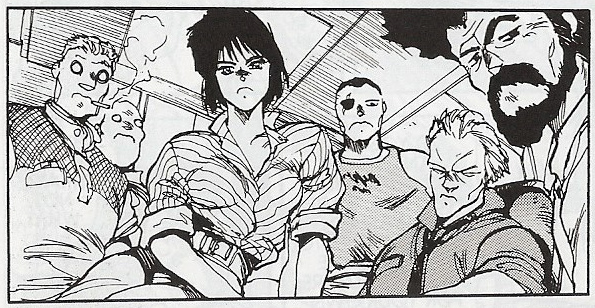
The manga starts with a prologue that quickly but densely explains to us a key aspect of how the world has organic components and computer circuitry working together. This allows for humans to have cybernetics implanted into their bodies, or to have a human brain be placed into a robot to become a cyborg, or where artificial intelligence (AI) has improved so well that robots can be confused for humans. A world where vast networks are interconnected between one another and controlled by large central AIs known as cyber-brains. All of this leads to a new era of cybercrimes where individuals can even hack into a human's brain (known as ghost-hacking) where they can "program" a human to perform a task like committing murder.
During the prologue, Section 9 has not yet been established. We see Aramaki and Kusanagi acting under two different outfits with Aramaki working in the Public Security agency while Kusanagi's team is like a "group for hire" kind of like the A-Team. ;-)
Aramaki, wanting Kusanagi and her group to work for him, has Public Security hire her team for an assignment where he tests them out to see how they handle a real scenario where their decisions may cause some serious ripples and create a political scandal. Well, they do raise some hell, and an outburst she makes with the Minister of Internal Affairs (which controls Public Security) causes the deal to be cancelled. However, Aramaki made a better deal where he was able to not only go above the Internal Affairs minister and deal directly with the Prime Minister, thus cutting IA out of the equation, but was able to triple the new unit's budget by a huge amount. Pretty slick.

And with this is when Section 9 is established.
In the manga, each chapter is noted with a date for reference, and they appear in chronological order. The prologue (chapter 1) takes place in March 2029 with the second chapter taking place a few months later in April. Taking place in July, Chapter 3 is the first mission where we see everyone working as one entity under the group known as Section 9. With it, we see the team trying to solve an assassination attempt on the leaders of the new Gavel Republic -- a former military nation now democratic -- where someone is hacking into the Foreign Minister's interpreter by ways of a ghost-hack. Colonel Malles, the former boss of the military government, is supplying aid to a faction back home that have taken over a platinum mine. He's working with Nakajima, an agent from Japan's Intelligence Agency who's also taking a cut of the profit from the platinum mines in exchange for giving Malles political asylum in Japan. They hired a hacker to construct the assassination plan which involved having one guy being brainwashed into thinking he's working for the new democratic Gavel Republic and wants to take out their leader, showing how there is a rift with the new government.
He plants what is called an HA-3 hacking system along a trash collector's route that he executes by calling a number with payphones along his garbage route, who's also brainwashed into thinking he's been hacking his wife's thoughts because of a messy divorce, but is actually using the HA-3 system to hack the Foreign Minister's interpreter, who would be ghost-hacked into killing the leaders of the Gavel Republic during a meeting with the Foreign Minister. In the end they arrest Nakajima and Malles and also describing how the brainwashing is actually a simex "simulated experience" -- a software dream that injects false memories.
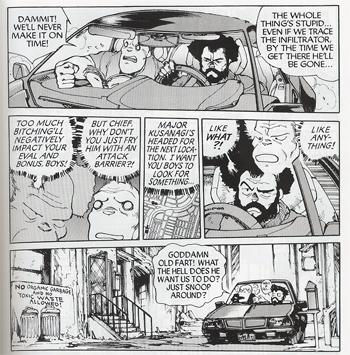
That was the CliffsNotes version of the chapter. It's to demonstrate how it closely follows in line with the typical television crime drama formula in showing the team going through a case by starting with a single piece of evidence from a crime scene to where in the end we find out who's the master mind behind the crime, using the A leads to B which leads to C method of storytelling. As one of the better chapters in the manga, its pacing is great and the complexity of combining politics, diplomacy, and a new age crime was well put together.
Some of the chapters in this manga follow the same pattern, but there was one where it was less on storytelling and more about just showcasing a lot of fun action sequences. And there's nothing wrong with that!
In the chapter "Dumb Barter" Kusanagi is attacked at her home. Both Ishikawa and herself believe Toru Sama is behind it, as they failed to kill him on a mission four years earlier before the formation of Section 9. They think this attack was just a warning as he used the same tactic they themselves used to kill Toru's men. As a bargaining chip for his plan, Sama's got info about Anaconda, a drug dealer and is referred to as the "Ghost of South America" from the Benten family (a mob like organization) to use as bait for Section 1, another Public Security group similar to Section 9. He told S1 the deal was for Anaconda to destroy the Benten family, and then for S1 to put down Anaconda. Soma would then get Kusanagi for his part of the deal. In addition, Sama got S1's heavily armored Think Tank to try and take down Kusanagi. After Soma and Kusanagi battle each other at an abandoned warehouse, the cavalry arrives in time to force Soma out of the tank where Kusanagi had the opportunity to kill him, and took it. After the incident, Aramaki and Kusanagi explain how they already had plans in place to take out Anaconda and the mission should have already ended with success, wrapping everything up neat and tidy before the end of the day.
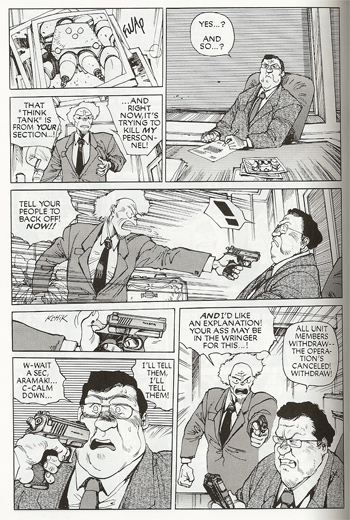
While the prologue got us ready for this futuristic world, it was chapters 4 and 5 that helped flesh it out. Here, not only do we get a short story of how an AI wants equal social rights like humans do and is confused about why humans do the things they do when the philosophy of religion is involved, but we also get a crazy in-depth explanation of how cyborgs are manufactured, allowing Masamune to go wild on what materials he believes can be used such as for skin or applied as sensors for feeling. So with these two chapters we get a sociological and engineering lesson on how humans interact with technology. Remember, this was written back in 1989/90, folks, and some of this "new technology" is commonly used today in real life (like fiber optics); though not for what he's written it for in this story, of course.
Probably the coolest technology in the GitS world has to be the Fuchikomas, which are one-seater tactical tanks used by members of Section 9. About the size of a car, they resemble an insect like a spider due to its arthropod look of having a segmented body with jointed limbs. They include a number of camera lenses on the front giving the impression of having multiple eyes, and are uniformly painted red. With them, a person can operate one by crawling inside of a Fuchikoma, can be controlled remotely, or give it commands to act independently due to its AI system. Each one has a personality similar to a child and usually gives comic relief when they are not currently being operated. They are very mobile and can scale walls, jump on to rooftops, and move at high rates of speed. They are an important asset to S9 and are used quite a lot during missions.

The last third of the manga consisting of chapters 9, 10, and 11 all involve one case dealing with a genius hacker nicknamed "the Puppeteer." In the beginning, it appears as though someone is hacking into high security facilities and causing a ruckus, where in one instance a robot was built and constructed by itself and then fled the compound. In this case it was Megatech Body Inc., a highly valued company dealing with developing and manufacturing cyborg parts. While it escaped, it purposely gets itself captured by S9.
Section 6, led by a man named Nakamura, tries to get custody of the robot and get the case away from S9. Nakamura tells Aramaki inside of the robot is the ghost of the Puppeteer. At this moment, the robot comes to life claiming to be a life-form and requests for political asylum. It describes itself as a life-form "spontaneously created from the sea of information." S6 steals the robot, but is later captured again by S9. When Kusanagi does a brain dive on the now damaged robot where its brain is slowly "dying," she discovers it was originally an AI developed by Neutron Inc, a company which Nakamura closely works with. Called Project 2501, it was a secret plan designed to increase company points by collecting info on corporations, info gathering, and operations; injecting itself into specific ghosts to increase corporate and individual points. The AI tells Kusanagi the programmer of Project 2501 thought of this self-aware part of the AI as a bug and placed it into a physical body to disconnect it from the net. At this point, the AI is about dead and goes into Kusanagi's own body.
This chapter gets psychological in some aspects, dealing with life itself, but the real deeper discussions will occur later. Nakamura eventually gets arrested because the program (project 2501) was used to manipulate power. Kusanagi, who almost got herself killed by brain diving too deep into the robot to get the Puppeteer, reflects about what she experienced while diving and what it all means, especially the divine vision she saw just before blacking out when the robot's operations shutdown.
While at this point in the story, it's interesting to note of a common occurring theme dealing with Aramaki. Towards the end of a few cases when the team discovered and arrested or charged the leader of the crime, Aramaki makes comparisons to how easily he could be the one on the other side wearing the handcuffs. In chapter 6 "Robot Rondo," an old friend of Aramaki's who was formally in charge of Intelligence is charged with taking part of a crime in the way of accepting bribes. Here his former colleague notes that one day Aramaki will be the same as him. In another chapter, a ranking officer in Public Security was found as an accomplice to an international crime. With this discovery, Aramaki makes comparisons to the accused with himself, noting how even those in Public Security, like him, can be persuaded into corruption by personal gain. Even Nakamura of Section 6 gives Aramaki a lecture of what he does in Section 9 is no different to what he did while in Section 6. Although this time, Aramaki tries to differentiate by saying he fights criminals while Nakamura fights powers in a political and economic sense.
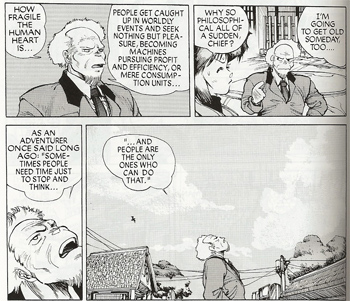
Chapter 10 gives us the total package of what we would see in a TV crime drama where one part is a court trial and another a dramatic hostage incident where time is of the essence.
After botching a case by accidentally killing the leader of a criminal group, Kusanagi and Section 9 are thrown into the public spotlight when a video of the incident gets leaked to the press. Kusanagi, not feeling 100 percent since the Puppeteer incident (and may be the reasoning why she wasn't mentally focused during the task), is now charged for the crime and needs to appear in court where she's pretty much guaranteed to be going to prison, where she'll be vulnerable to being assassinated. This all stems from a heavy dosing of political drama where essentially Israel and Syria are fighting a war of influence and Japan is caught in the middle. In the end, it was Israel who leaked the video of Kusanagi killing the person, exposing S9 and placing them into the spotlight. Kusanagi is going to prove it was Israel, but she needed to ditch her court appearance and go out on the law.
So as explained, the Major flees her court session while it was in a short recess because she knows she will be thrown in prison even if she admits to killing (she'll just get a shorter time in jail if she admits guilt) and she knows she'll be assassinated while in jail. Also, to prove that Israel was behind it all besides Kusanagi's actual shooting of the group's leader: the Syrian assassination plan, the supply of weapons, the involvement of S9, the video leak, and the terrorism, was an Israeli op (I left a lot out here because I didn't want to explain everything related to the case in this chapter. Read the manga if you're interested!). To have everyone think she's dead, she makes a scene by taking a hostage where she will be shot and killed, but her ghost is really with Batou as they escape. S9 got evidence that Israel was the culprit by finding the Israeli mole who was contacting an Israeli intelligence agency where they cut a deal with one of the snipers at the hostage scene to take down Kusanagi. They do and kill her by shooting her in the head.
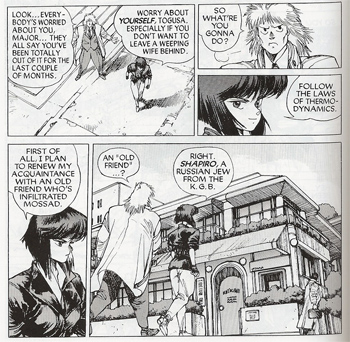
In chapter 11, Batou takes Kusanagi's ghost (her brain) to a secret hideout where they have a spare body, but it's damaged and can't use it. In the meantime, a gang is infiltrating their hideout and Batou needs to take care of the situation. Kusanagi goes into low power mode to conserve energy so she doesn't use up all of her battery life (otherwise her brain will die). While in this mode, we find out the Puppeteer has been hiding in her net this whole time. It wants to fuse with Kusanagi's ghost so it can reach its full potential. To summarize, it needs "slack," and is susceptible to something like a computer virus. This AI needs to fuse with a human ghost so it can become a true life form, gaining that "slack" and can continue on to gain its full potential. Kusanagi, while initially hesitant about the idea, agrees and the AI truly fuses with her ghost and they both become one being where one does not overpower the other (no split personality). Batou gets a body from one of the gang members, but didn't know it was a male body (oops!). Kusanagi, now under the guise of this body, is now free to explore the net.
This last chapter delves into a deep discussion about how the Puppeteer, where one such as itself, can survive a catastrophic event but also preserve what it has in ways of intelligence by gaining a so called "slack" it does not poses in its current form. It goes on to talk about how individuals, with their genes and memes, are micro in the cosmos of things, but are still an integral part for the higher, macrocosmic levels, where the fluctuations of the lower levels prevent a hardening of the arteries of the upper levels. And with this, the Puppeteer uses the theory of "the hardening of the system" as the primary argument as for why Kusanagi should allow it to fuse with her ghost. While Masamune uses a mixture of ideals he got from reading books regarding the definition of life, biology, physics, and his own belief of things, it creates a sort of psychological stew I really don't get on board for, but one that makes sense for the world he created for GitS (although its summarized better in the feature film based on the manga). I guess when it comes to this type of subject, it's up to the individual reading the manga to make their own conclusion whether they buy it or not.
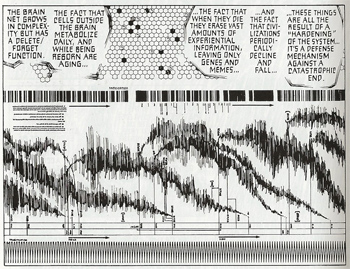
But when you dial it back and look at the bigger picture, Ghost in the Shell is about the melding of mental thinking and machinery thanks to technological advances of computer systems and networks; how civilization coexists with it all, and how it has an upper hand at the moment, but is struggling with the advancement of AI and why it's sometimes challenging dealing with it, fearing that one day the tools it created may surpass it. Batou makes note of this towards the end of chapter 10.
And with these talks about technology, identity, and social issues, it's all wrapped in an awesome cop drama where we get some action along with it, so you get a good mixture of action with deep thoughts on how we all fit into the world that seems on the brink of a great cataclysm. No wonder it's such a popular series!
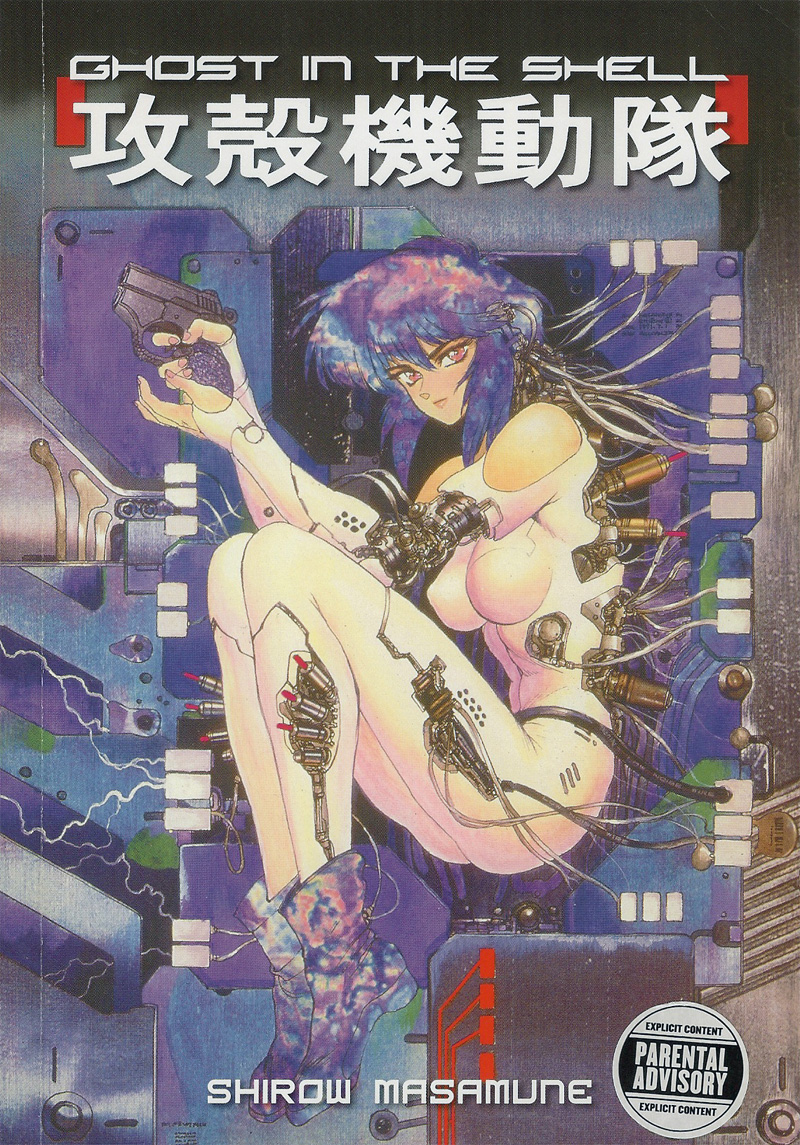 |
Ghost in the Shell
JP Original Print: 1989 US Release: 1995 368 pages |
Posted on: January 19, 2017
